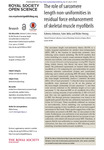| dc.contributor.author | Johnston, Kaleena | en_US |
| dc.contributor.author | Jinha, Azim | en_US |
| dc.contributor.author | Herzog, Walter | en_US |
| dc.date.accessioned | 2016-10-11T05:37:32Z | |
| dc.date.available | 2016-10-11T05:37:32Z | |
| dc.date.issued | 2016 | en_US |
| dc.identifier.other | HPU4160717 | en_US |
| dc.identifier.uri | https://lib.hpu.edu.vn/handle/123456789/23612 | |
| dc.description.abstract | The sarcomere length non-uniformity theory (SLNT) is a widely accepted explanation for residual force enhancement (RFE). RFE is the increase in steady-state isometric force following active muscle stretching. The SLNT predicts that active stretching of a muscle causes sarcomere lengths (SL) to become non-uniform, with some sarcomeres stretched beyond actin–myosin filament overlap (popping), causing RFE. Despite being widely known, this theory has never been directly tested. We performed experiments on isolated rabbit muscle myofibrils (n=12) comparing SL non-uniformities for purely isometric reference contractions (I-state) and contractions following active stretch producing RFE (FE-state). | en_US |
| dc.format.extent | 9 p. | en_US |
| dc.format.mimetype | application/pdf | |
| dc.language.iso | en | en_US |
| dc.subject | Cellular and molecular biology | en_US |
| dc.subject | Biomechanics | en_US |
| dc.subject | Physiology | en_US |
| dc.subject | Residual force enhancement | en_US |
| dc.subject | Sarcomere length non-uniformity | en_US |
| dc.subject | Myofibril | en_US |
| dc.subject | History dependence | en_US |
| dc.subject | Descending limb of the force–length relationship | en_US |
| dc.subject | Sarcomere popping | en_US |
| dc.title | The role of sarcomere length non-uniformities in residual force enhancement of skeletal musclemyofibrils | en_US |
| dc.type | Article | en_US |
| dc.size | 547KB | en_US |
| dc.department | Education | en_US |

